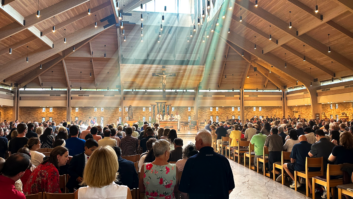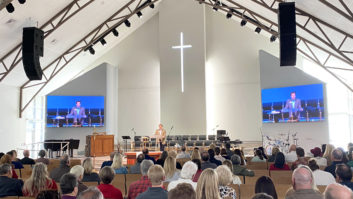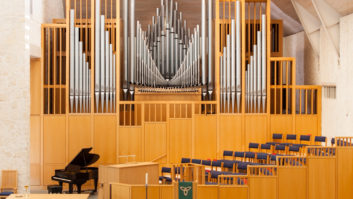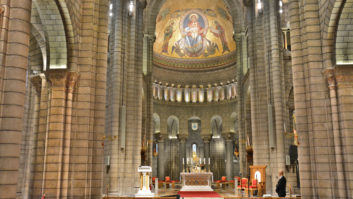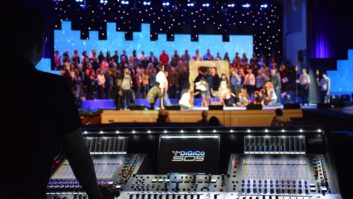The development of technology for what is now referred to as the houses of worship (HoW) market has gone through at least two major phases since the 1970s. First there were straightforward sound reinforcement systems – typically a lectern or early radio microphone connected to an amplifier feeding a small number of column loudspeakers – so that everyone in the congregation could hear the vicar, priest, minister, rabbi or imam. By the 1980s and into the 90s, this had grown further with the use by some churches, particularly those in the evangelical tradition, of larger sound systems for music performances, along with video recording of services.
That trend continued over the last 30 years, with other faiths adopting these technologies to a greater or lesser extent depending on the size of the house of worship in question. More recently, like other areas of AV, the HoW market went through fundamental changes during the Covid pandemic as churches and other places of worship attempted to continue ministering to their respective communities at a time when large gatherings were prohibited. Live streaming of services became essential and led to other ‘new media’ activities, such as virtual meetings and events, becoming necessary parts of HoW life.
“Some churches in the UK were live streaming long before the pandemic but the majority was not,” comments Phill Beynon, a director of installation company NoiseBoys Technologies. “Unsurprisingly, we have seen a huge increase in the number of churches wanting or needing to offer a stream of their services since the beginning of 2020. As they closed their doors out of necessity in the pandemic, churches moved online, some very simply, others very creatively and inventively.”
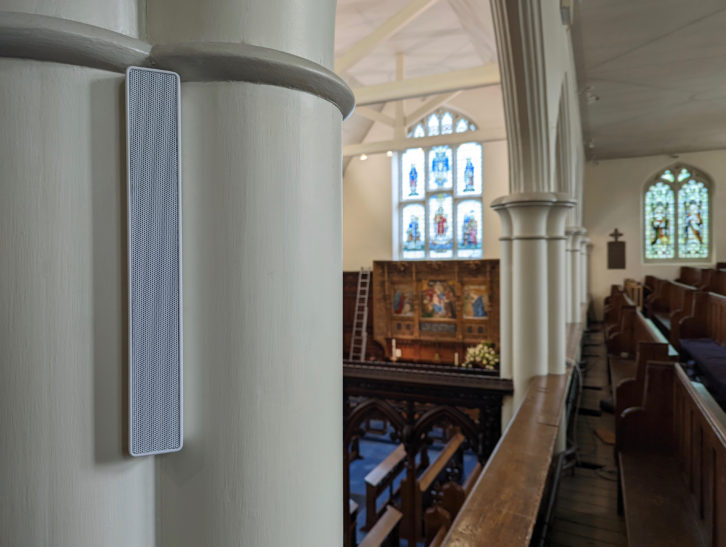
This has ranged from simple 4G internet systems to allow the connection of a mobile phone for direct steaming from entry-level PTZ (pan tilt zoom) and fixed cameras connected to Blackmagic Design ATEM Mini or Elgato Stream Deck switchers, all the way up to full switching/streaming/distribution systems such as vMix or NewTek TriCaster connected to high-end cameras lie the Panasonic AW-UE150. “A positive for me has been helping churches that would have never seen a need for streaming pre-pandemic really embracing it as a way to connect people post-pandemic,” Beynon says. “More traditional churches are now using it to connect families across the world for weddings and funerals of loved ones and also to include those parishioners who are unable to go to the physical church due to health reasons.”
REMOTE STREAMS
David Tewksbury, product and application support specialist for distribution covering north America and Canada at HARMAN, agrees that “even the smallest of churches” were forced to provide remote streams of services over the last two years. “They have also, wherever possible, made broadcast feeds available to an outdoor campus or even someone’s car in the parking lot via the car stereo,” he says. “In order to survive, houses of worship have to be able to reach their congregations and that means streaming live and on-demand platforms are a priority.”
A recent HoW installation featuring HARMAN equipment was the Eun-pa Church in South Korea. Local distributor TechDataPS installed Crown amplifiers and JBL VTX A8 line array, which was chosen personally by the church’s pastor. Tewksbury observes that for audio, a separate mixing position is necessary so studio monitors can be used to mix the broadcast feed. Other essentials, he says, are “a robust network running networked audio [typically Dante]; networked video encoding capable of bumping the video down to H.264 for broadcast; and either a dedicated website or a channel on a platform like YouTube”.
The South Korean HoW market appears to be particularly active right now, with Seoul-based pro audio company DaonSD designing a system for the Tongyeong Juklim church based around a KV2 ES system. The installation also features a large LED screen behind the pulpit, which project manager John Parks says is becoming more widespread in Korea as a way to augment the “worship experience”. It does, however, mean that care has to be taken to prevent feedback due to more reflective surfaces.
REVERBERANT ENVIRONMENTS
Jonathan Reece, head of global sales strategy at KV2 Audio, comments that highly reverberant environments are a regular challenge faced by HoW installers, who have to take care to preserve “character and nuances” in a reader’s voice. “The same [is true] with worship bands when multiple instrumentalists and singers require definition and separation,” he says,.” Especially to be heard clearly above the acoustic sound of, for example, a drum kit in a reverberant space.”
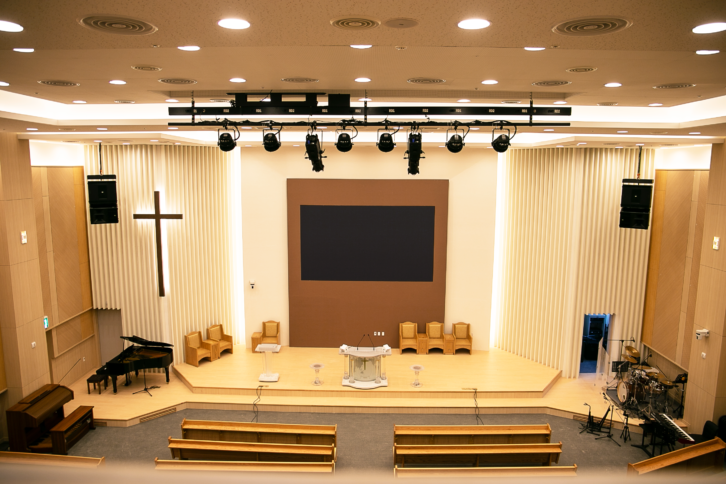
Minimising reflections, whether in a historic country church, a big cathedral, mosque or synagogue or a modern evangelical house, is even more of a priority due to the streaming of services. “From a live audio point of view, broadcasting while services are running makes keeping a quiet stage more important,” agrees Robin Dibble, product support engineer at Martin Audio. “Churches have their own live streaming channels, in some cases their own TV channels, and lockdown pushed more in this direction. It is now necessary to keep sound off the stage so a clean mix is possible to the streaming service.”
To do this, Dibble explains that “tight directional control” in the mid and high frequency ranges is a prerequisite. Martin Audio has also incorporated the Hard Avoid feature into systems such as MLA to work round difficult areas such as behind and below an array, balconies and ceilings. Dibble adds that “pretty much everything” is now on a network, including audio, video and control. “Networked audio, such as Dante, allows multiple destinations – monitors, video production, net radio – to pick the audio they need from the network, which could be individual microphones or complete mixes from the front of house desk.”
While IP is now well established for the networking of both audio (AoIP) and video, not every implementation in the HoW sector is to carry programme sources. “In general the vast majority of IP for church installations is for control,” comments James Cooper, managing director of installation company Flipside. “We don’t tend to do a lot of AoIP and usually networking kicks in with larger channel counts or the physical size of the venue.”
Flipside started out as a dedicated audio installer, working in live sound, theatre, hospitality and the education sector as well as HoW. Cooper says more elements have been added over the years, including cameras, streaming, AVoIP, digital signage and assistive listening. “Churches can be a little polarised, with 100V line systems and a lot of loudspeakers to a big cathedral with more sophisticated installations involving steering columns. We’ve also widened into the middle ground, providing sophisticated but easy to use systems that have the longevity and lower cost people are looking for.”
EDUCATION PARALLELS
Michael DiBella, director of commercial product marketing at Crestron, draws a parallel between HoW and the education market, where schools and colleges are actively trying to attract students by not only investing in technology but using it in a more engaging way. “Everything we do in life is now moving towards these experiential type atmospheres and immersive experiences,” he says. “I don’t see why [something] faith-based should be any different.”
At InfoComm in June this year, Crestron introduced Sightline, which is described as a “room experience”. The technology is based on a range of existing Crestron platforms and while it is aimed primarily at the meetings market, DiBella says it could also be applied to HoW: “Sightline is designed for that immersive experience, to capture not only the people at home but all the people around a desk. But I think you’re going to see essentially conferencing technology with that intelligent video experience within a house of worship, so it’s not just a single or dual camera back and forth on a preacher, you’re also getting dynamic feedback coming out of the parishioners.”
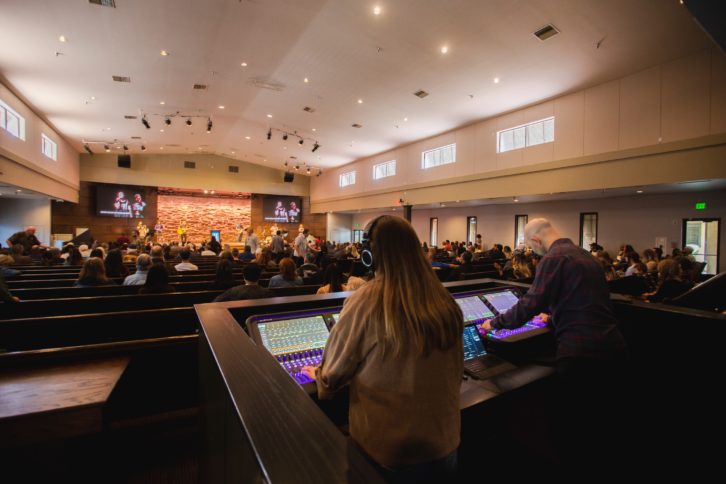
While technological considerations for HoW are moving into ever more highly developed areas, there are still practical concerns such as enabling people to run the sound and video for a service smoothly and efficiently. As with any kind of production, this relies heavily on good communications, which comes down to an intercom system. In the faith market, however, those working with the AV equipment are unlikely to be professionals, so the kit has to be user friendly.
“HoW can be very transient in terms of who is using the technology,” observes Gary Rosen, vice president of global sales at wireless intercom specialist Pliant Technologies. “The people using the comms gear don’t have to be trained because it is very straightforward to use. Even a small church still needs a level of communications, as well as those set-ups with multiple buildings where there is a lot of live streaming and recording.”
Technology in houses of worship of worship has come a long way from an incumbent obviously wearing a lavalier microphone and a couple of boom mics on some singer-guitarists. While that basic equipment was able to reach out to the congregation in the physical place of worship, modern technologies are necessary to take services beyond those walls and into people’s homes, something that is only likely to increase in the future.
